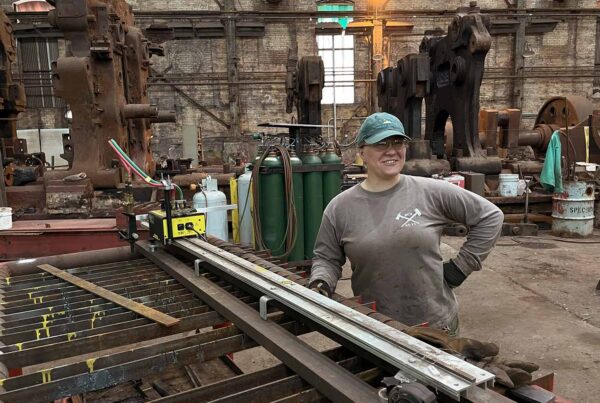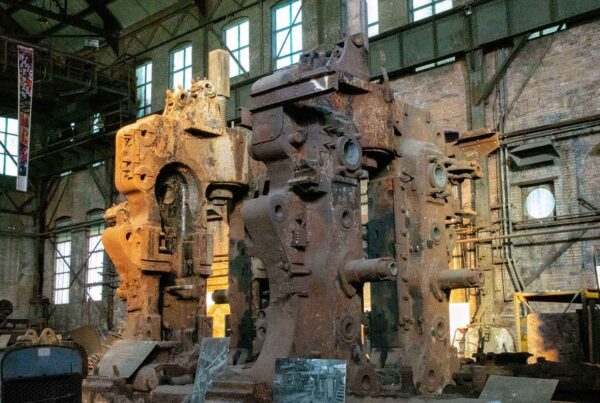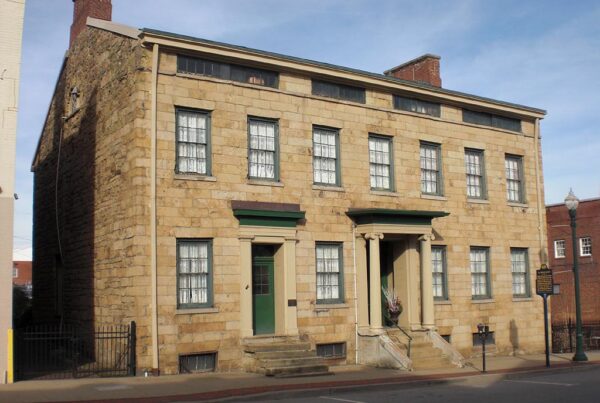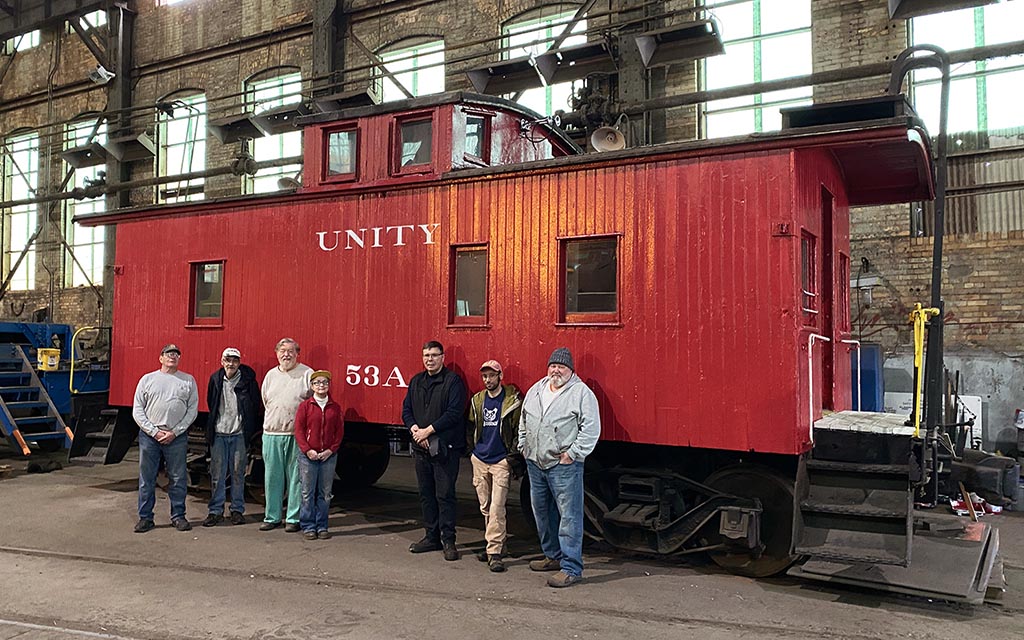
The caboose restoration volunteer crew: Keith Clouse, Mike Lickert, Kevin Scanlon, Shelley Parkerson, Ken Dunay, Matt Kory, and Andy Wagner. Dave Dudjak and Rich Proctor participated in the restoration, but are not included in the image.
The Restoration of the Unity Railways Caboose 53A
With the help of a dedicated team of volunteers—and a donation from a longtime community partner—a second railroad car has been restored at the Carrie Blast Furnaces. The Caboose will help interpret the relationships between local railways and the mills, and also share the specific stories about a short line operation and small mining communities in eastern Allegheny County.
By Rivers of Steel staff
Restoring the Caboose—A Volunteer Story
“Yes, we’ll do it!” Kevin Scanlon spoke for a crew of volunteers, including his friend Mike Lickert.
Both volunteers, the two men organize a cadre of helpers who regularly rise to the occasion to maintain and improve the condition of the Carrie Blast Furnaces National Historic Landmark. When presented with the opportunity to restore a historic caboose, which is housed in the Blowing Engine House on the landmark site, it was an easy “yes.” After all, the volunteers had already rehabilitated the exterior of the Pusher Engine onsite a year or two prior.
“The caboose had been sitting inside the Blowing Engine House since being donated to Rivers of Steel by the Pennsylvania Trolley Museum in Washington, Pennsylvania,” said Kevin. “Over the years, the paint had been peeling, and the wood siding had some rotten spots. The idea was to make it presentable so that it eventually can be an interpretive piece on the role of railroads’ interactions with steel mills.”
The volunteers’ activities generally stop from late October until landscaping duties pick up again in the spring. While this project gave the volunteers something to work on indoors during the winter, it—like the 48-Inch Universal Plate Mill—was a project that had been in an arrested state, waiting for a moment when time and resources could converge.
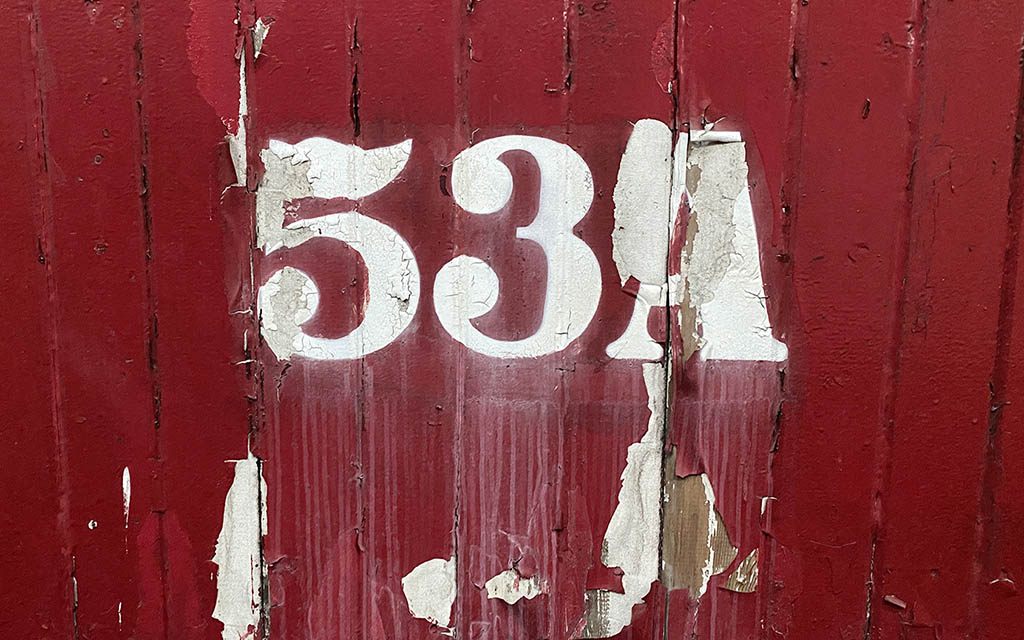
The only identifying mark on the caboose when it came to Rivers of Steel was a white 53A. The number indicated the year that the Unity Railways purchased it.
“The caboose was painted a deep red, and the only identifying mark was the number ‘53A’ painted on one side,” Kevin continued. “Scott Becker, the executive director and CEO of the trolley museum, provided a starting point for the restoration. He shared that while it was built in 1915 by the New York, Ontario & Western Railway at the Middletown, NY, shops, Unity Railways purchased it in 1953. And since Unity Railways was a small coal-hauling railroad serving the town of Renton in eastern Allegheny County, Scott suggested we restore it using the Unity Railways paint scheme since that was what could align best for our eventual use as an interpretive object. He went on to share that the interior was the same as when they received it from Unity Railways in 1965, so it only made sense for us to match the exterior.”
Unity Railways was a three-and-a-half-mile short line interchanging with the Pennsylvania Railroad and the Bessemer & Lake Erie (B&LE) Railroad in North Bessemer, Pennsylvania, a historic industrial neighborhood now within Penn Hills Township, along the border with Renton region Plum Borough. The B&LE was one of U.S. Steel’s railroads. It took coal and iron ore from the Great Lakes and mines near North Bessemer down to the Pittsburgh-area for the steel mills. When the coal plant on the Unity closed in 1965, the caboose was donated to the Pennsylvania Trolley Museum, where it often housed Santa Clause during its Christmas celebrations.
After establishing the provenance of the caboose, the volunteers got to work. Working with Ron Baraff, Rivers of Steel’s director of historic resources, it was decided to repaint the caboose as close as possible to its appearance during its time with Unity Railways.
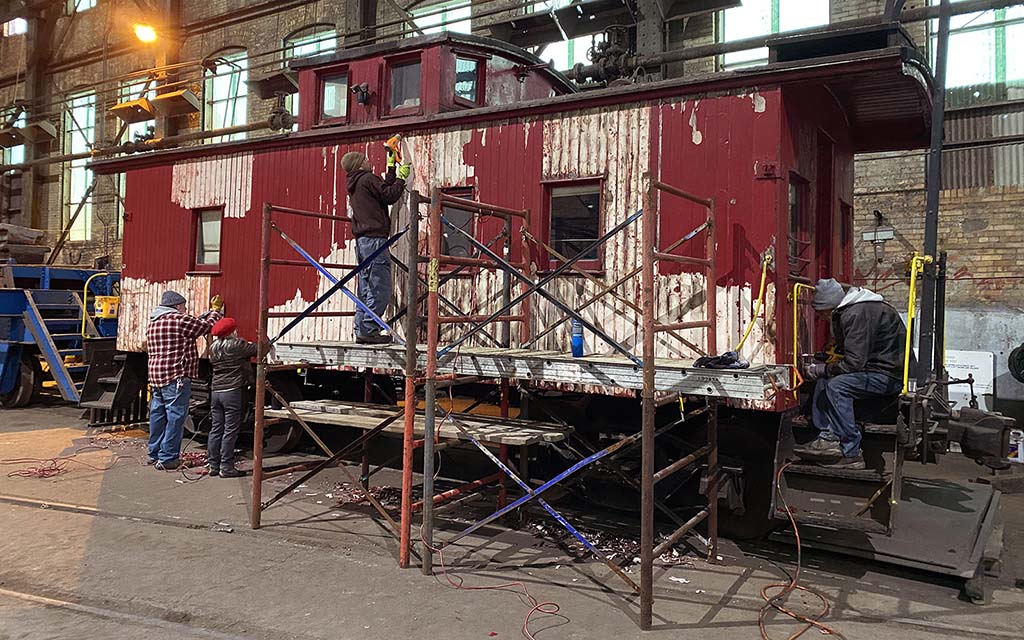
Andy Wagner, Shelley Parkerson, Matt Kory and Mike Lickert strip paint from the caboose.
“The exterior paint was separating from the primer,” Kevin went on to say. “This may have indicated that the oil-based paint was applied over latex primer. Some of the wooden siding was so rotten that you could poke a finger through it, and a quadrant of tar paper was missing from the roof. New paint could not go over the bad base, so we began stripping the paint. That took place from November of last year through March 2024. It was done using heat guns and a propane torch, then sanded—not an easy task on those cold winter days!”
Ten of the tongue-and-groove siding boards had to be removed and replaced with new wood. Other spots were patched with fiberglass. The platform floor on one end was completely replaced. In March, the first coat of primer was applied, followed by a new shade of red that was close to the original color.
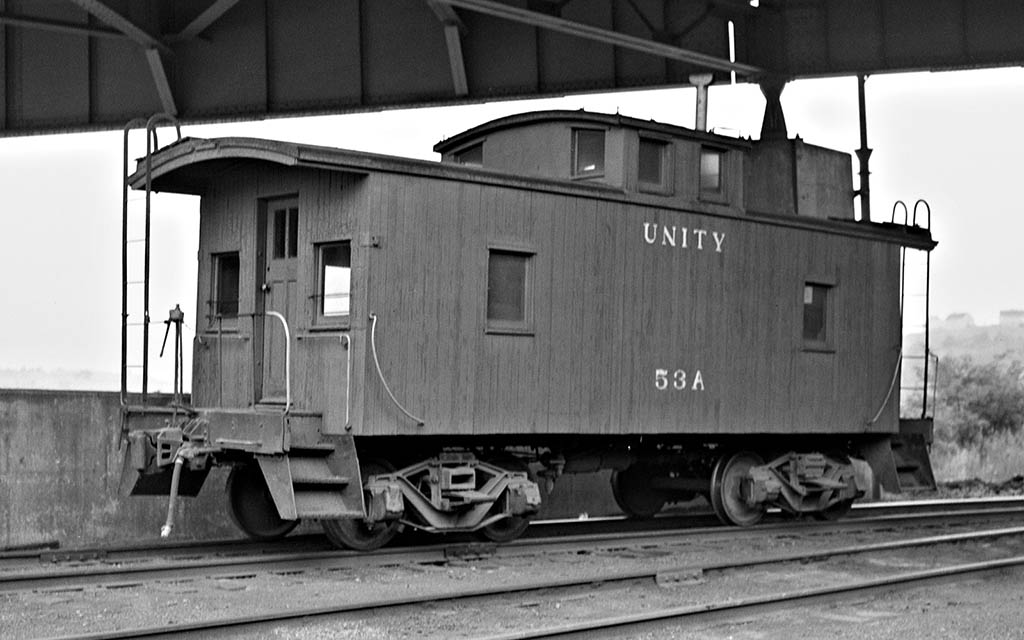
The Unity Railways Caboose 53A parked under the Pennsylvania Turnpike overpass at Unity, PA. Original photo from 1954, courtesy of David Dudjak.
David Dudjak, a railroad enthusiast who has provided technical assistance to Kevin and the volunteers in the past, supported this project as well. “The proper lettering was a bit of a challenge,” said Kevin. “David helped quite a bit with finding the correct font. As only Dave would put it, ‘It appears the lettering is Railroad Roman . . . not to be confused with Lulu Roman of Hee Haw fame.’” Kevin went on to share that David provided good advice on how to create and use lettering stencils, in addition to locating an original negative image of the caboose from 1954 that established the placement of the lettering.
Additional volunteers were involved with the restoration of the interior, which retails its original Caboose Interior Green paint. “The interior was in good condition,” Kevin shared, “but a few features were missing and others were added. Rich Proctor, with assistance from Andy Wagner, has been working on wiring to add interior lighting and outlets for future displays. And, since the short rails on the Unity sometimes had to back up a distance, the caboose was equipped with an air horn to warn motorists at crossings. Mike Lickert restored the horn; it’s now connected to a small air compressor. You should hear it!”
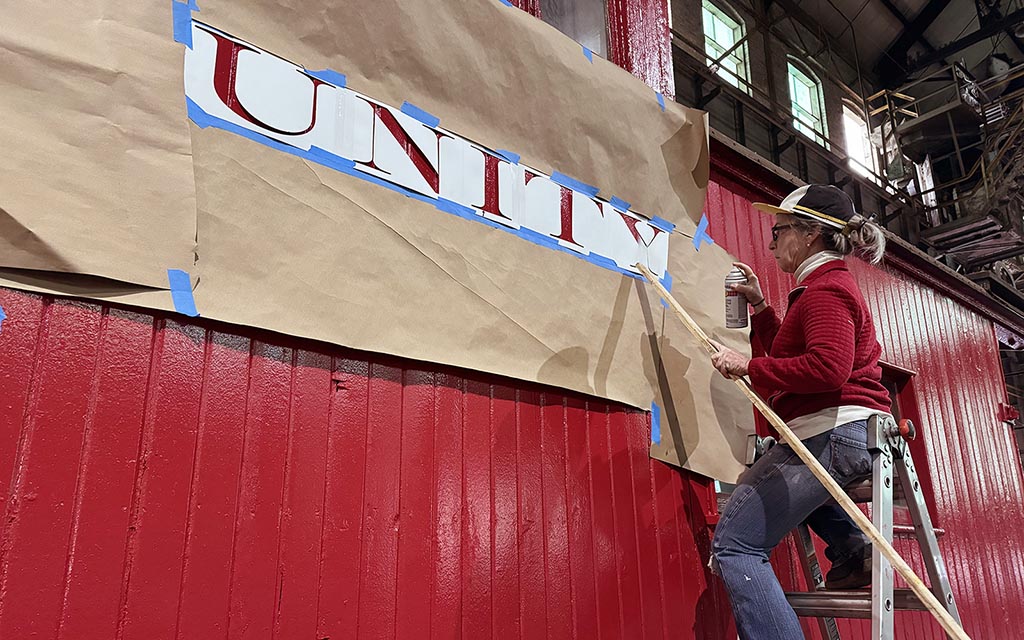
Retired paint chemist Shelley Parkerson had the honor of painting the new lettering stencils.
“The Carrie volunteer crew never ceases to amaze me,” said Ron Baraff. “They approach their tasks—often those that would be considered the most mundane—with such great enthusiasm. Their excitement about a project gets us excited as well. I’m thankful for all of them but especially Kevin Scanlon for his leadership in orchestrating the recent restoration efforts on the Unity Caboose. Our generous volunteers brought our cool little caboose back to life with great skill and devotion. They are such knowledgeable folks with so much to offer. Honestly, I cannot say enough good things about them.”
Kevin Scanlon also warmly extended his gratitude to the team: “A big THANK YOU to all of the restoration crew: Keith Clouse, Dave Dudjak, Ken Dunay, Matt Kory, Mike Lickert, Shelly Parkerson, Rich Proctor, and Andy Wagner!”
Interested in volunteering? We’d love to hear from you! Throughout the spring, summer, and fall, volunteers assist in maintaining the landscaping at the Carrie Blast Furnaces, in addition to helping with projects such as the restoration of the Unity Railways Caboose 53A. Work sessions are generally Wednesdays and / or Saturday mornings from 9:00 a.m. to noon. No special skills are required, but you might just learn some new ones! Email volunteers@riversofsteel.com to learn more.

